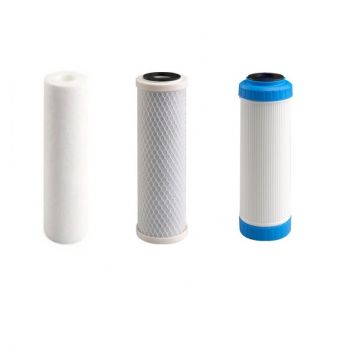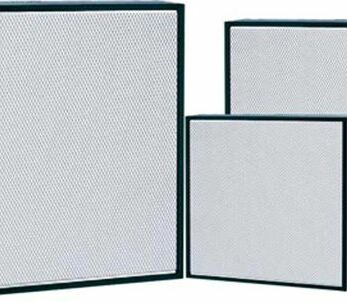What is secondary filtration?
A secondary filter (also known as an intermediate or medium filter) removes large to medium dust particles (≥0.4 micrometers) and is positioned between the coarse filtration stage and the high-efficiency filtration (HEPA) stage in an air filtration system.
What is Secondary Filtration?
Secondary filtration (also known as intermediate or fine filtration) removes large to medium dust particles (≥0.4 micrometers) and is implemented at the middle stage of an air filtration system, between coarse filtration and HEPA filtration.
Characteristics of Secondary Filtration
- The filter material of the secondary filter is made from synthetic PE fiber, glass fiber, or other materials.
- The frame of the secondary filter is made from galvanized steel, aluminum, or stainless steel.
- The filter medium is designed according to the EN 779 standard.

Filtration Efficiency of Secondary Filters
Similar to coarse filtration, secondary air filtration is also designed according to the EN 779:2012 standard. Secondary filtration can remove 0.4-micrometer dust particles with an average efficiency ranging from 40% to 95% or higher, corresponding to filtration levels M5, M6, F7, F8, and F9.
More specifically, secondary filters with levels M5 and M6 (EN 779) are referred to as intermediate or medium filters, while those with levels F7, F8, and F9 (EN 779) are known as fine filters.
Common Types of Secondary Air Purifiers
The two most popular types of secondary filters on the market are plate filters and bag filters.
Bag-Type Secondary Filter
- The frame is made of materials such as aluminum, galvanized steel, or stainless steel.
- The air filter bag is made from synthetic materials such as glass fiber or PE fiber.

| Size (mm) | Rated air flow (m3/h) | Head pressure difference (Pa) | |||
| M6 | F7 | F8 | F9 | ||
| 592x592x380 x6 bags | 2400 | 60 | 100 | 120 | 140 |
| 287x592x380 x3 bags | 1200 | ||||
| 592x592x480 x6 bags | 3000 | ||||
| 287x592x480 x3 bags | 1500 | ||||
| 592x592x560 x6 bags | 3400 | ||||
| 287x592x560 x3 bags | 1700 | ||||
| 592x592x560 x8 bags | 4500 | ||||
| 287x592x560 x4 bags | 2250 | ||||
| 592x592x760 x8 bags | 5000 | ||||
| 592x592x940 x8 bags | 6000 | ||||
| 492x492x560 x6 bags | 2500 | ||||
Plate and Box Secondary Filters
- Frame: Can be made of aluminum, stainless steel, galvanized steel, or other durable materials.
- Filter membrane: Can be made from materials such as glass fiber (for high heat resistance), synthetic fiber (for abrasion resistance), activated carbon (for odor removal), or metal mesh (for oil and water filtration).
Some common sizes of secondary air filter in the form of plates and boxes:
| Size (mm) | Rated air flow (m3/h) | Head pressure difference (Pa) | ||||
| M5 | M6 | F7 | F8 | F9 | ||
| 592x592x46 | 3400 | 60 | 60 | 100 | 120 | 140 |
| 287x592x46 | 1700 | |||||
| 492x492x46 | 2200 | |||||
Use of Secondary Filter - Medium Filter
Secondary filtration is applied in residential and public spaces (hospitals, schools, commercial centers, office buildings) as well as in industries (medical equipment, pharmaceutical clean rooms, food production, electronics, painting, and interior manufacturing).
The secondary filter is installed in air filtration equipment such as FCUs, AHU air handling systems, and home HVAC systems.

When is the Secondary Filter replacement time?
Secondary filtration is the second stage in the air filtration system, following coarse filtration, where it primarily captures fine dust particles, as large dust particles are removed during the coarse filtration stage.
Filter Installation and Maintenance Instructions
Plate-type Secondary Filter
- Gently open the packaging and handle the filter by its frame, avoiding contact with the filter membrane.
- Filters should always be stored in their packaging to prevent contamination or damage.
- Install the filter plate according to the airflow direction indicated by the arrow.
- Use gaskets to seal any gaps between the filter frame and the air filtration device.

- Some filter plates are single-use and must be replaced after use.
- For reusable filter plates, maintain them by gently cleaning or vacuuming.
- Do not wash with water or expose them to strong air pressure or harsh chemicals.
Bag-Type Secondary Filter
- Carefully open the filter housing, handle the filter by its frame, and avoid contact with the filter material.
- Ensure the filter is installed with the filter bag positioned vertically.
- Avoid contact between the filter bag and any sharp edges of the device.
- Verify that the filter bags are intact and not stuck together.
- Attach gaskets, and apply sealant to gaps if necessary.
- Most bag-type secondary filters are disposable and need to be replaced after use.



















